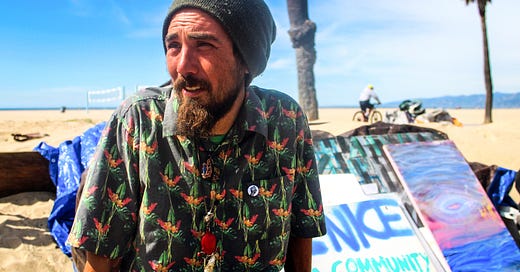The Brewing Battle Over Venice Beach’s Homeless Crisis
In one of the hippest (and priciest) places in America, homeless shelters are overcapacity and tent cities are on the rise. While many residents are eager to sweep the streets clean, one homeless artist sees a chance to build community.

Photos by Emily Mae Czachor
At ten o’clock on a chilly Tuesday morning, the Venice boardwalk is beginning to stir. A blanket of rich mid-morning sunlight coats the horizon, and the glittery silhouette of the Santa Monica pier twinkles like a kaleidoscope in the distance. Souvenir shops and tattoo studios emerge, one by one, from behind their rusty metal barricades while artists and street performers unload their respective paraphernalia along the boardwalk’s opposite periphery. They are the eclectic fringe that counters Venice’s commercial establishments in a quiet, mostly cordial, face-off between craft and corporate interest. Catty-corner to Snapchat’s former headquarters at the upscale beach-bungalow-inspired Blu House, 34-year-old Reed Segovia stands barefoot behind a wooden table not much larger than a high school classroom desk. Behind him, slabs of wood repurposed as makeshift canvases flaunt a medley of geometric neon portraits, stacked in a semi-circle formation like a psyched…
Keep reading with a 7-day free trial
Subscribe to Narratively to keep reading this post and get 7 days of free access to the full post archives.



